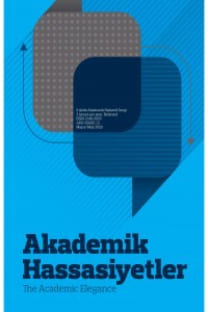AKADEMİDE MOBİNG VE CİNSİYETÇİLİK: ÇUKUROVA ÜNİVERSİTESİ ÖRNEĞİ
MOBING AND SEXISM IN THE ACADEMIA: THE CASE OF ÇUKUROVA UNIVERSITY
Academia Gender Inequality, Mobbing,
___
- Abelson, R. P. (2012). Statistics as Principled Argument. Psychology Press.
- Brown, M. B., &Forsythe, A. B. (1974). The Small Sample Behavior of some Statistics which Test the equality of Several Means. Technometrics, 16, 129-132.
- Büyüköztürk, Ş. (2004). Sosyal Bilimler İçin Veri Analizi El Kitabı. (4. Baskı). Ankara: Pagem A Yayıncılık.
- Çögenli, M. Z., & Asunakutlu, T. (2016). Akademide mobbing: ADIM üniversiteleri örneği. Erzincan Üniversitesi Sosyal Bilimler Enstitüsü Dergisi, 9(1), 17-32.
- De Beuckelaer, A. (1996). A Closer Examination on Some Parametric Alternatives to the ANOVA F-test. Statistical Papers, 37(4), 291-305.
- Gage, M. J. (1870). Women as Inventors. Woman Suffrage Tracts, No. 1. Fayetteville, NY: FA Darling.
- Hewish, J. (1969). Emily Brontë: A Critical and Biographical Study. Springer.
- Huizingh, E. (2007). Applied statistics with SPSS. Sage.
- Ján, J., & Eva, L. (2008). Demographic and Organization Factors Analyses in Relation to Mobbing in Companies. In Proceedings of the Management 2008 conference in Times of Global Change and Uncertainity (p. 430). FON.
- Kline, P. (1994). A general description of factor analysis. An Easy Guide to Factor Analysis.
- Leymann, H. (1990). Mobbing and Psychological Terror at Workplaces. Violence and victims, 5(2), 119-126.
- Leymann, H. (1996). The Content and Development of Mobbing at Work. European Journal of Work and Organizational Psychology, 5(2), 165-184.
- Mahbuba, D., & Rousseau, R. (2011). Matthew, Matilda and the others. September 20-23, Istanbul Bilgi University, Turkey, 348.
- McKay, R., Arnold, D. H., Fratzl, J., & Thomas, R. (2008). Workplace bullying in academia: A Canadian study. Employee Responsibilities and Rights Journal, 20(2), 77-100.
- Namie, G. (2007). The Challenge of Workplace bullying. Employment Relations Today, 34(2), 43.
- Nordstokke, D. W., & Zumbo, B. D. (2010). A New Nonparametric Levene test for Equal Variances. Psicologica, 31(2), 401-430.
- Palaz, S., & Boz, İ. (2008). Üniversite Mezunu Yetişkinlerin Farklı Organizasyonlarda Gönüllü Hizmet Vermesini Etkileyen Faktörler. Balıkesir Üniversitesi Sosyal Bilimler Enstitüsü Dergisi, 11(19), 95-106.
- Park, H. M. (2009). Comparing group means: t-tests and one-way ANOVA using Stata, SAS, R, and SPSS.
- Prevost, C., & Hunt, E. (2018). Bullying and Mobbing in Academe: A literature. European Scientific Journal, 14(8), 15.
- Rossiter, M. W. (1993). The Matthew Matilda effect in science. Social Studies of Science, 23(2), 325-341.
- Salin, D. (2001). Prevalence and forms of bullying among business professionals: A comparison of two different strategies for measuring bullying. European Journal of Work and Organizational Psychology, 10(4), 425-441.
- Sevinç, E. T. (2011). Mobbing with a gender perspective: how women perceive, experience and are affected from it. Yayımlanmamış doktora tezi, Ortadoğu Teknik Üniversitesi, Sosyal Bilimler Enstitüsü, Ankara.
- Sonzamacı, E. (2013). Bilim Dünyasında Alışılmadık Bir Kadın Portresi: Marie Cruie. Retrieved from http://politikart1.blogspot.com.tr/2013/07/bilim-dunyasinda alisilmadik-bir-kadin.html
- Strickland, O. L. (2003). Using Factor Analysis for Validity Assessment: Practical Considerations.
- Stevens, J. (1996). Appied Multivariate Statistics For The Social Science (Third Edition). New Jersey: Lawrence Erlbaum Associates.
- Tabachnick, B. G., Fidell, L. S., & Ullman, J. B. (2007). Using Multivariate Statistics (Vol. 5, pp. 481-498). Boston, MA: Pearson.
- Taber, K. S. (2018). The use of Cronbach‟s Alpha when Developing and Reporting Research Instruments in Science Education. Research in Science Education, 48(6), 1273-1296.
- Tigrel, E. Y., & Kokalan, O. (2009). Academic Mobbing in Turkey. International Journal of Behavioral, Cognitive, Educational and Psychological Sciences, 1(2), 91-99.
- Tomić, M. (2012). Mobbing: The incidence of Mobbing Activities and Differences Regarding Workplace and Gender. Megatrend Review, 9(1).
- Vveinhardt, J., & Štreimikienė, D. (2017). Demographic, Social and Organizational Characteristics on the Levels of Mobbing and Single Cases of Harassment: The Multicomplex Approach. Economics and Management.
- Yıldırım, H., & Uysaloglu, B. (2012). Impact of Demographic Factors on Employee's Perception of Mobbing: A Case Study from a Logistics Company. Procedia-Social and Behavioral Sciences, 58, 634-644.
- YÖK. https://istatistik.yok.gov.tr/ . Date of Access: 5 Temmuz 2020.
- Žukauskas, P., & Vveinhardt, J. (2009). Socio-demographic Characteristics of Mobbing and Discrimination in Employee Relations. Transformations in Business & Economics, 8(3), 18.
- ISSN: 2148-5933
- Yayın Aralığı: 3
- Başlangıç: 2014
- Yayıncı: A Kitap
RASYONEL SEÇİM TEORİSİ İLE ORGANİZE SUÇLARI ANLAMAK
DAĞITIMCI VE SOSYAL EŞİTSİZLİK EKSENİNDE EŞİTSİZLİĞİN FARKLI YÜZLERİ
TEKİLDEN ÇOĞULA EL DEĞİŞTİREN DİKTATÖRLÜK: İLLİBERAL DEMOKRASİ
Bilal YALÇINKAYA, Mehmet Ali GÖNGEN
Hakan REYHAN, Ayşen SATIR REYHAN
KENDİ OLMA SERÜVENİNİN ONTİK SANCISI: ÇİRKİN ÖRDEK YAVRUSU
SOSYOLOJİNİN KURUCU FİGÜRLERİNDE DİN
CARL SCHMITT: İSTİKRARDAN ‘İSTİSNA’YA SİYASAL DÜZEN
HARVEY’İN MEKÂN TARTIŞMALARI EKSENİNDE YAŞLILARIN GÖZÜNDEN KENTSEL DÖNÜŞÜM
Cem ERGUN, Ayşe DERİCİOĞULLARI ERGUN
